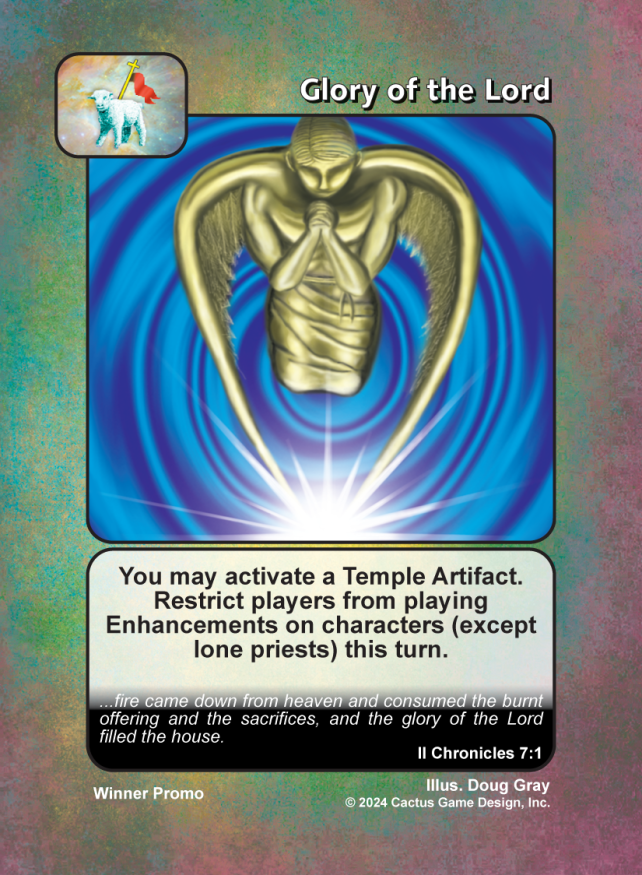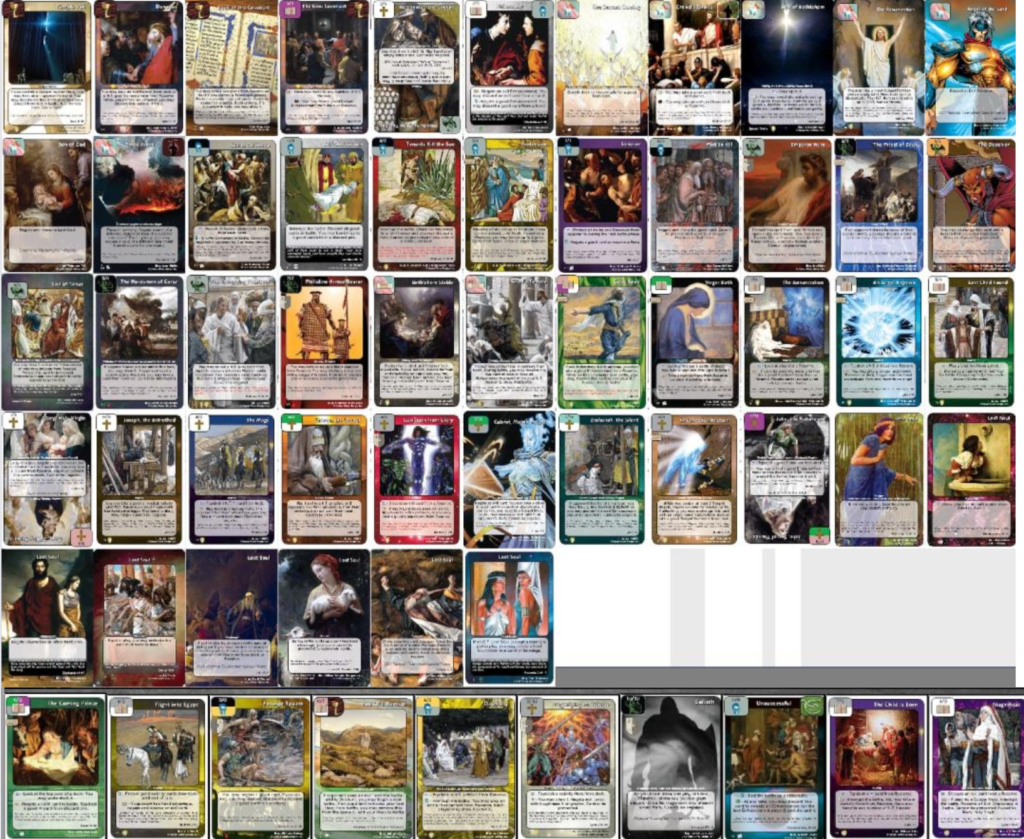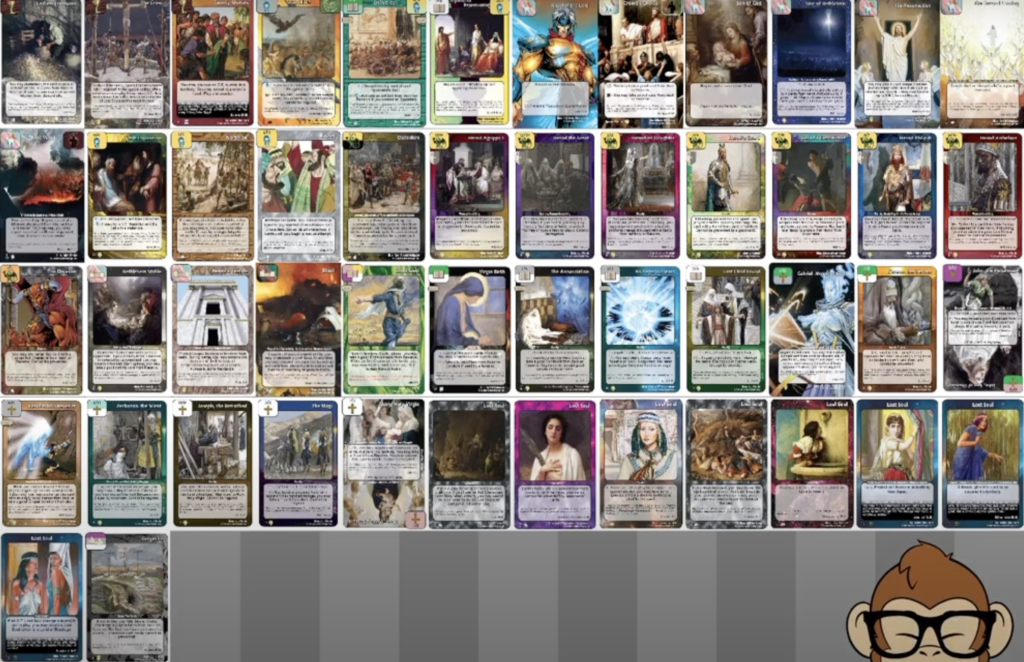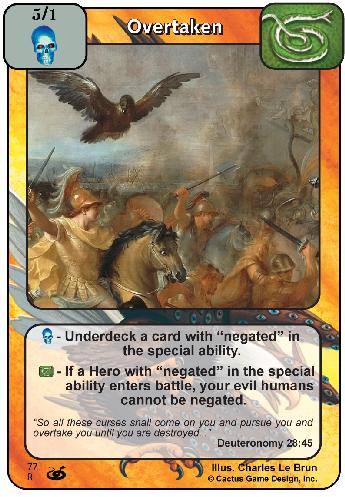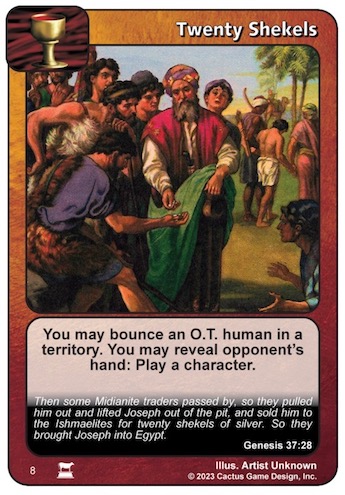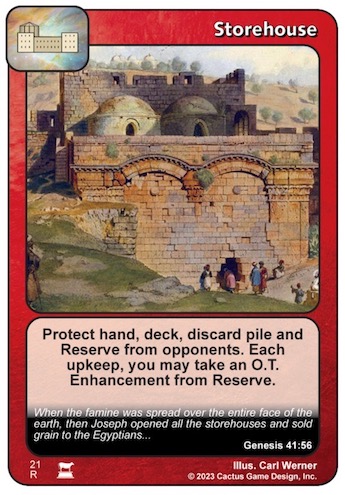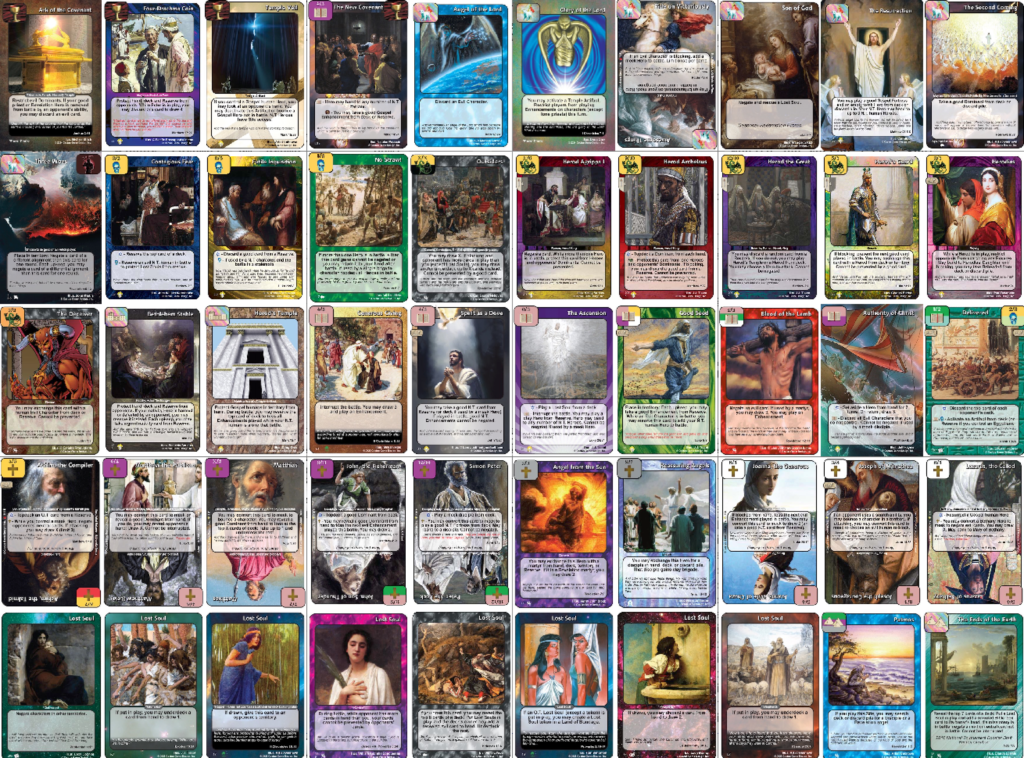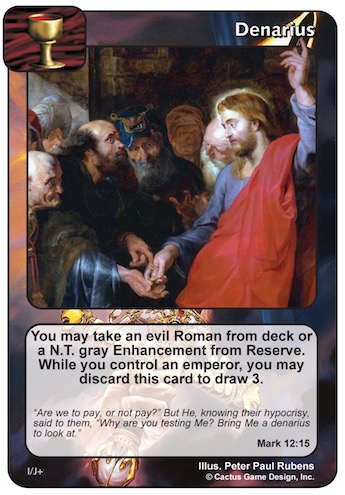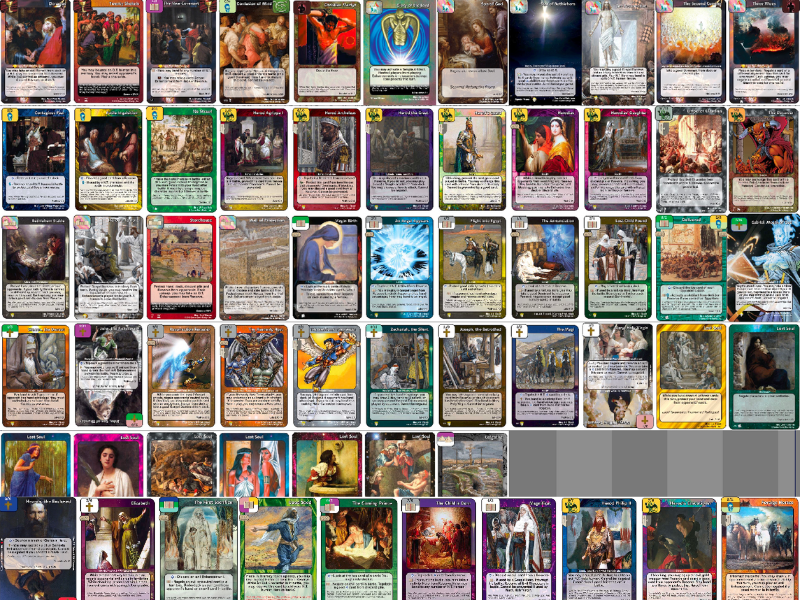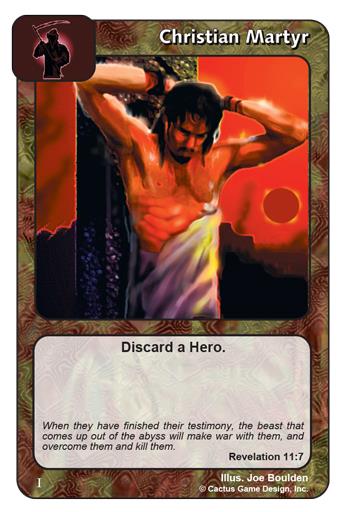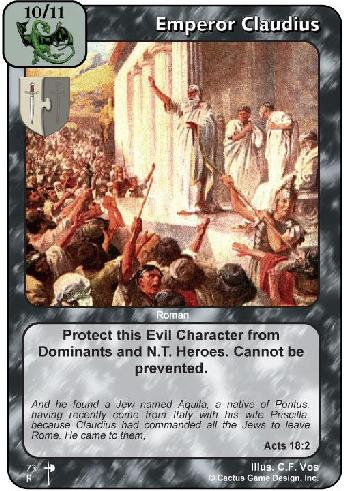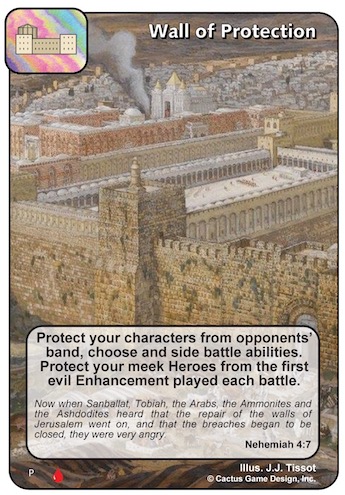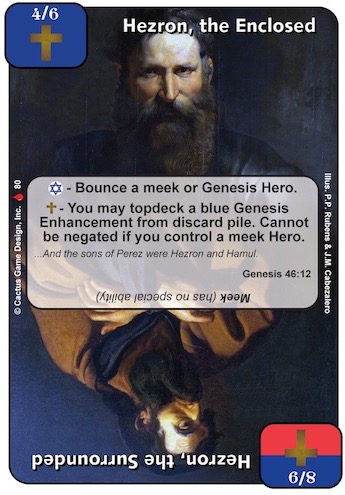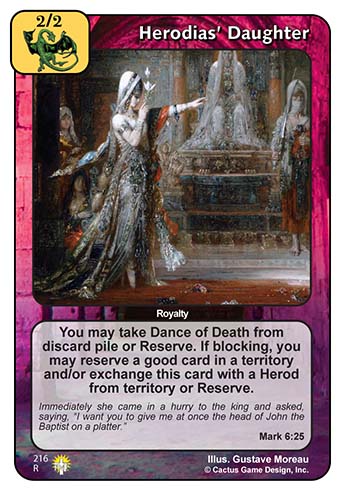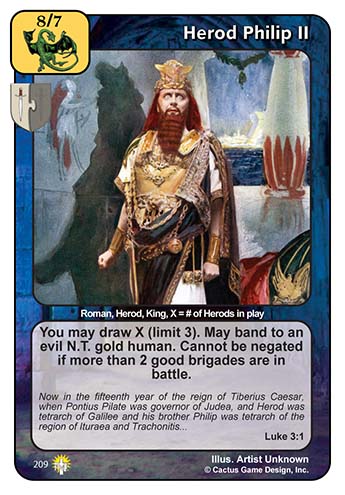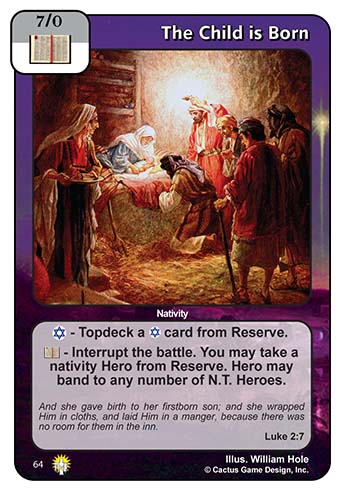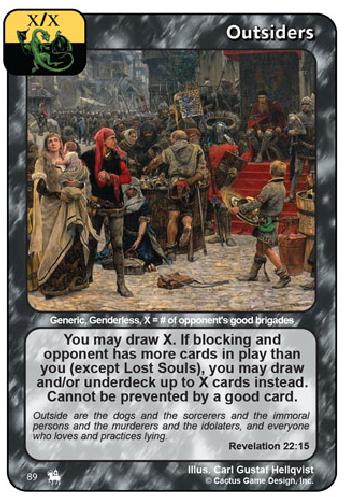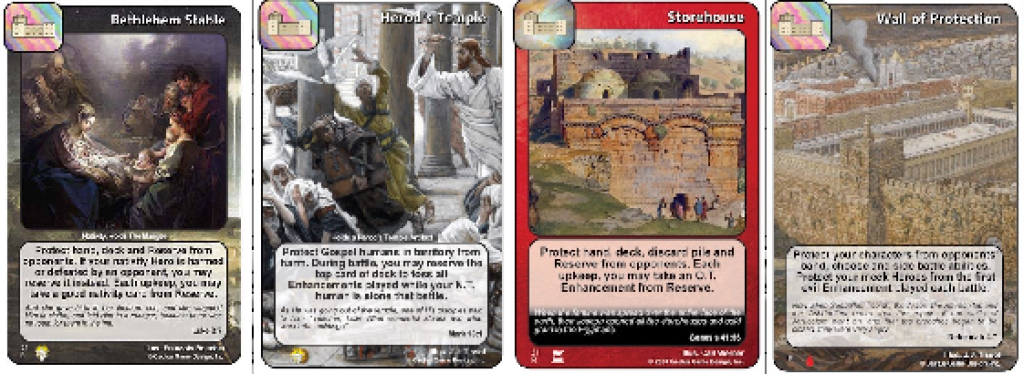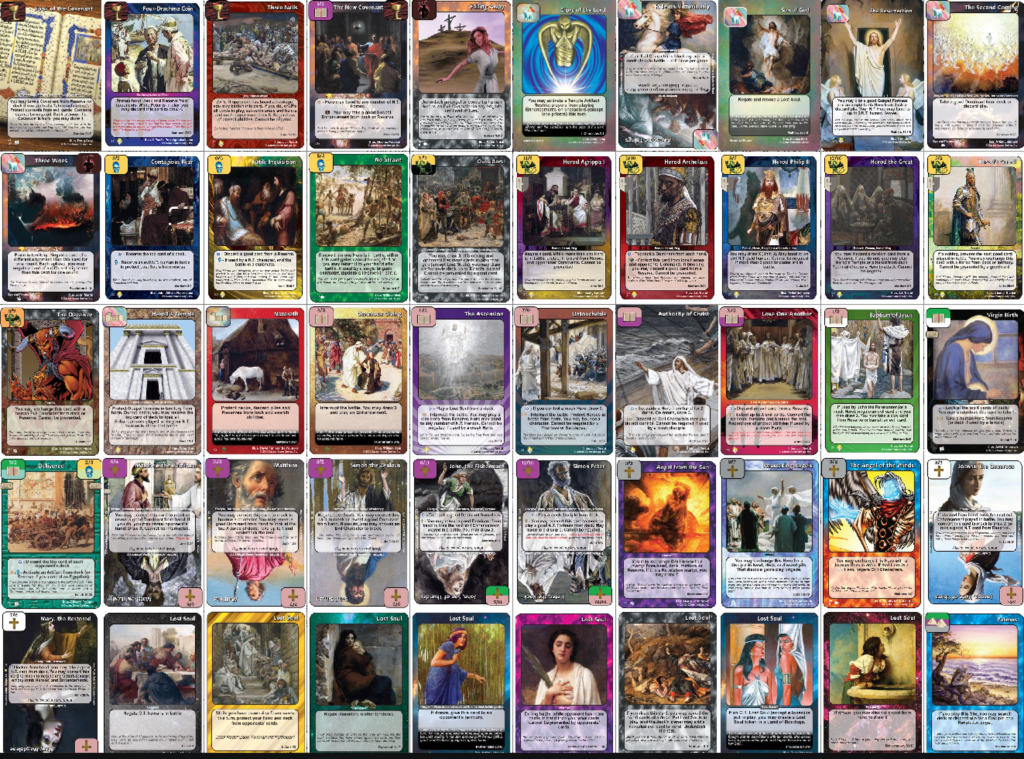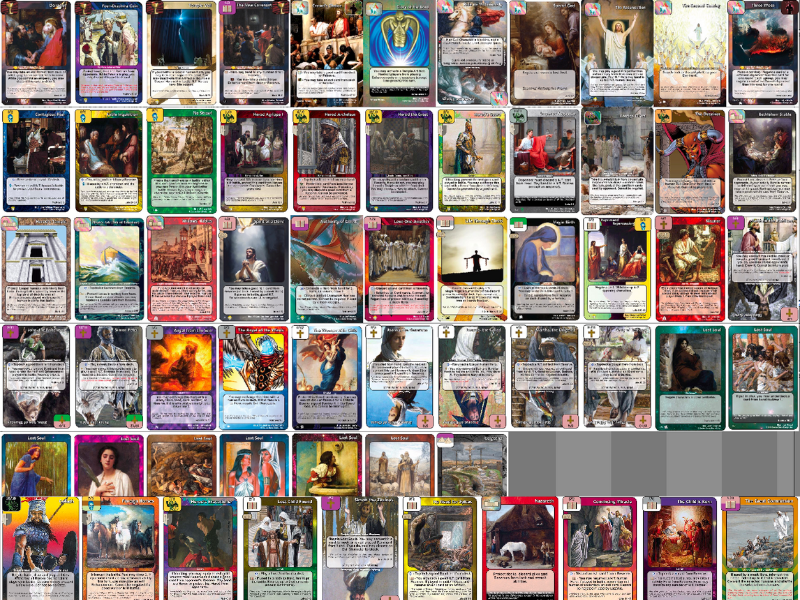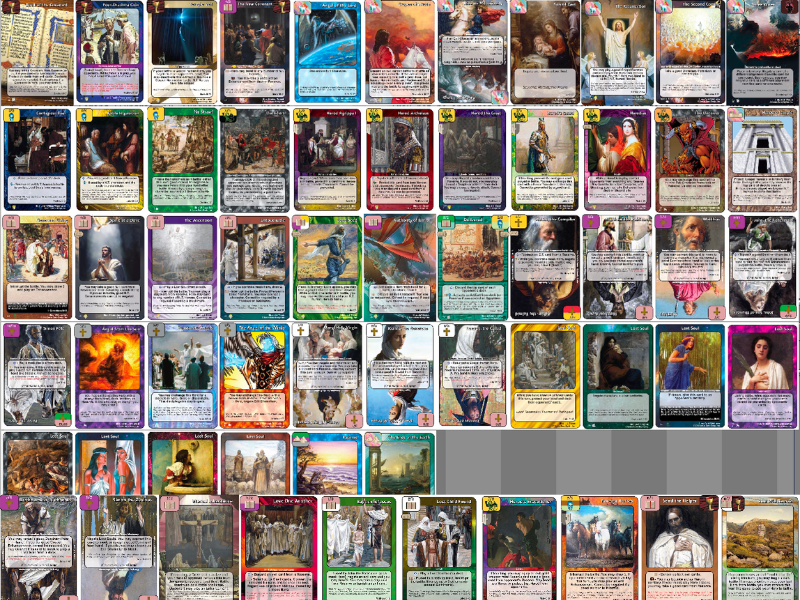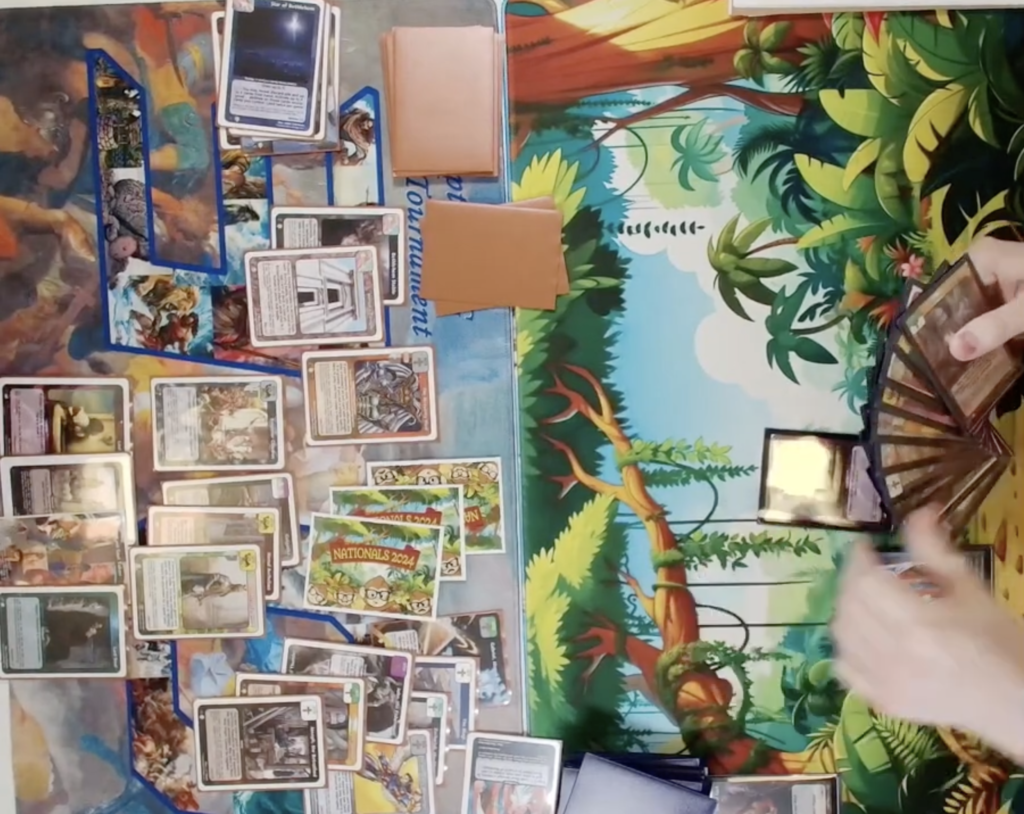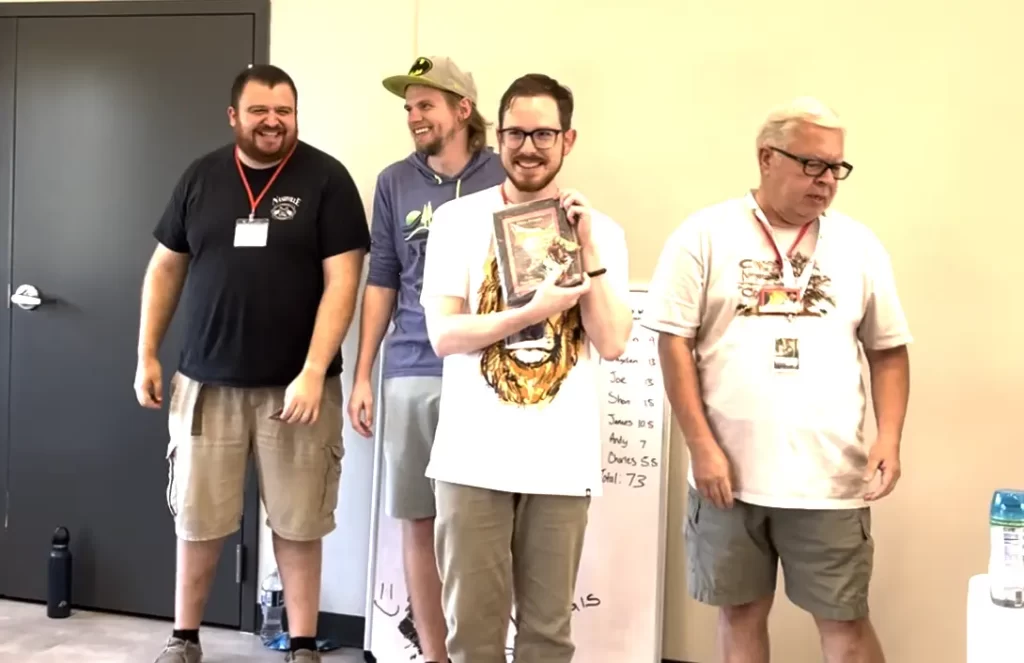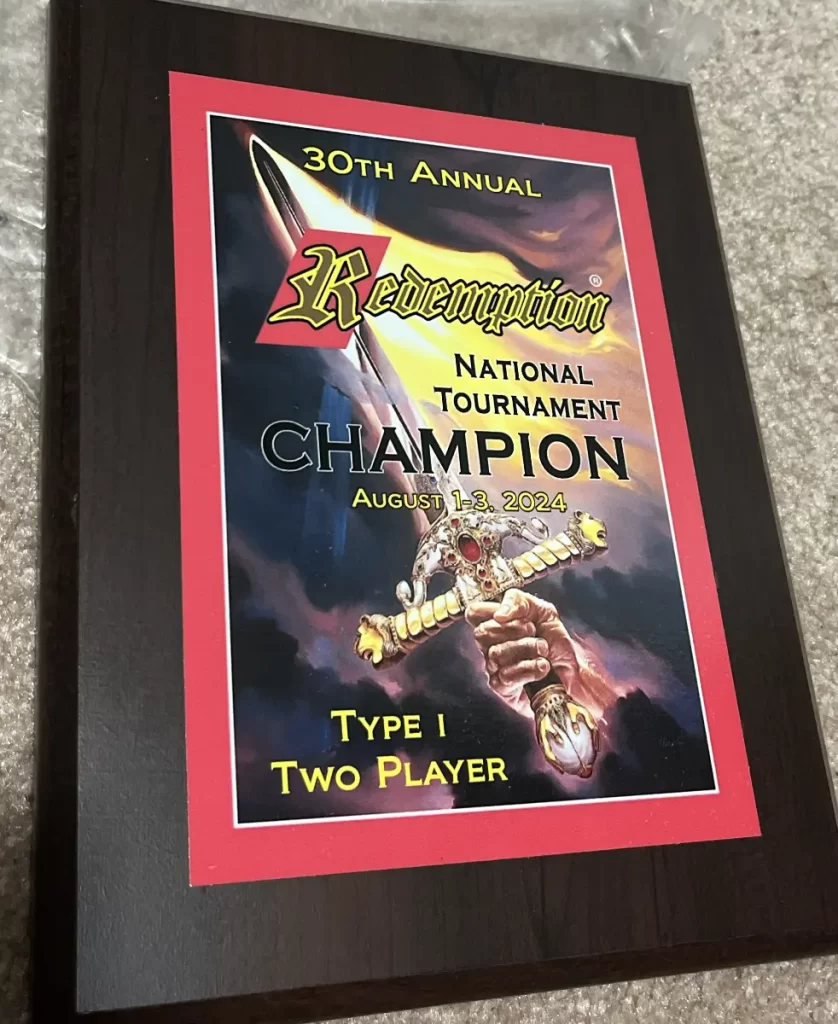I can say its been quite the journey since I started playing Redemption again in January 2024. If you went back in a time machine and told me I’d have a chance at taking down the main event of the biggest Redemption tournament a mere 8 months later, I would have thought you were delusional. But life is a funny thing; full of twists, turns, and surprises.
The Road to Nationals
My story at Nationals starts much earlier than the actual tournament. It began with the simple decision to start a Youtube channel focused on Redemption content. When my curiosity became peaked in the game in January, I noticed a lack of strategic content geared towards newer players and I decided to do something about it! I wanted to learn as much about Redemption as possible and share the lessons I’ve learned along the way to players who may be in the same shoes as I was.
I’m no stranger to card games (having a background in Magic: The Gathering) but I was a complete stranger to Redemption in 2024. I possessed a basic understanding of how a game of Redemption was played (left over from the time I played Redemption in my youth group growing up) but aside from that, nothing else. I didn’t even know any of the cards that currently compose the T1 rotation format!
Baboony Begins
I chose the moniker “BaboonyTim” because it felt like I was stepping into a jungle of the unknown. It captured the essence of being overwhelmed by something new but learning to adapt and then swing your way through something that used to seem so dense, so unapproachable. And at that time I had no idea how dense and deep Redemption’s strategy could be.
January 2024 was a unique time for me. I had recently been laid-off my job and had been floundering in all senses of the word (spiritually, physically, mentally, and emotionally). I had a bunch of God-given energy but possessed no outlet in which to invest it. Redemption became a healthy outlet of brain energy that I previously was using to worry about my finances and the future.
The decision to make Youtube videos felt like a turning point for me. Instead of waking up and feeling depressed about having nothing on my calendar, I suddenly possessed a reason to wake up because I had all these ideas I wanted to turn into videos! Between mastering the game and learning how to edit videos, I had something new to engage a brain that was desperately searching for meaning and purpose. At one point, I was making a YouTube video a day for the span of about 3 months.
I’ve since slowed down to a more sustainable pace (about a 2 videos a week) but there was something special about investing myself fully in something and being able to take all the information that was coming at me and getting to synthesize it into an entertaining video.
In college, I noticed students who engaged with the subject matter in the most ways possible (note taking, careful listening, and going back to listen to the recorded lessons) were the ones who tended to retain the information the best. In a similar way, my workflow for making videos encouraged me to really examine each game of Redemption I played. First, I would record each game. Then I would go back and rewatch each game, providing a commentary for it and noting important plays/misplays. Thirdly, I would then go and edit the video (effectively watching the game a third time).
By the time I had a gameplay video made, I would have gotten the chance to think about that game from 3 different perspectives: 1) while I was playing the game in the moment 2) watching the game after it happened 3) noticing what other people noticed during the game. By sharing the videos on YouTube, I got to learn things that I missed by having other people point out strategic misplays I had made during the match (Thanks Jake!) This helped shore up my blind spots and teach me about some of the more unintuitive rules of the game that I probably wouldn’t have ever learned if it weren’t for the YouTube comment section.
Learning the Meta
My first foray into the metagame of Redemption’s T1 format was studying some of the decks that had performed well at tournaments earlier that year, like Chad’s Soul Surfer deck, Jay’s HoneyPot deck, and Justin’s GoldenEye deck. I would highly recommend reading any articles Chad has written on Land of Redemption. These were foundational for me in helping me form an understanding about what some of the top decks were trying to accomplish and what strategies were powerful. In addition to studying the best performing decks, I would lurk in the Redemption Discord and follow the various discussions people were having about the most powerful decks.
During Lackey tournaments, I chose to learn how to play a variant of Nick Marshall’s National 2023 winning deck Clay/Herods. This is where I became acquainted with the power and speed of Matthew decks that would set the bar for any deck I tried in the future. Any future strategy I tried would always be compared to the baseline of these types of Matthew decks.
It was during that time I fell in love with the Herod defense. I loved how it played a different game than other defenses out there and tried to stop opponents from resolving their good enhancements in battle. The printing of Glory of the Lord made this gameplan even stronger.
Nativity/Herods
I didn’t want to limit my focus too early, so I kept exploring other strategies like Daniel and Patriarchs.
And after a while, I began to take notice of a Nativity based deck created by Jake Antonetz that he called “Newspaper.” He was using this deck to do extremely well in the online tournaments being run in March and April. You can read more about his Newspaper deck in a Land of Redemption article here.
Jake’s Newspaper March 2024
The reason he called it Newspaper was that it utilized a White and Silver based offense with a Gray and Black defense (which were the colors of a newspaper). I became immediately impressed by the consistency and power of the deck’s offense which would try to leverage the power of The Resurrection to gain an early advantage and then ride a bevy of powerful Nativity heroes to close out the game.
I loved how strong the early game of Nativity was but I also loved its late game. It could use The Coming Prince to recycle Star of Bethlehem and draw absurd numbers of cards in the process. It has some of the hardest to block attacks in the game thanks to the protect ability of Flight into Egypt plus most of its heroes have great stats and modifiers. It felt like Nativity had everything it needed to win games and take on clay.
I started experimenting with pairing the Nativity offense Jake had been developing with the Herod defense I had become impressed with during my experience of playing Clay/Herod decks. This deck proved to perform incredibly well against the best decks and I even published a YouTube video 5 months before Nationals called “If Nationals Was Tomorrow…” that talked about the Nativity/Herods deck I was working on and how much potential I believed it had. The first versions of the deck had a bunch of cards that ultimately didn’t make the cut in the version I showed up to Nationals with, but the core of the deck largely remains the same as the list I used at Nationals.
Nativity/Herods February 2024:
The first draft of the deck was built around Overtaken, which when paired with Nativity’s CBN (Cannot be Negated) heroes and the powerful Herods promised to yield powerful CBN protected blocks.
While having a CBN Herod Agrippa I sounds nice, I eventually realized I wanted to be doing something more powerful with my artifact slot:
This unassuming artifact from Israel’s Rebellion becomes a win condition when paired with Mary, Holy Virgin or John the Forerunner because you can play out any evil characters that may be hiding in the opponents hand and make them vulnerable to your Mary/John gameplan. This strategy really punishes decks running low numbers of evil characters.
Whenever I had the option to activate Twenty Shekels or Overtaken, I found that getting a good attack in with Twenty Shekels + Mary was usually the better play than trying to play defense. This is because Redemption is a game that by design rewards offense. You win the game through getting to 5 lost souls. You don’t win by blocking the opponent. In my opinion, if given the option to strengthen an attack or a block, the best option is usually to strengthen your attack.
This specific slot is a point of friendly disagreement between Jake and I to this very day. You’ll notice he chose to run Temple Veil instead of Twenty Shekels in his list that he brought to Nationals. Specifically, he was wanting to make sure he was able to activate Confusion of Mind (a defensive artifact) and also be able to activate Temple Veil on Herod’s Temple. But I firmly believe that if I have the option to activate Twenty Shekels or activate a defensive artifact, activating Twenty Shekels is the more powerful play.
The next big innovation I made was adding Storehouse to the maindeck. Not only is hand protection phenomenal (and something you can never have too much of), Storehouse is able to complement the Nativity strategy by consistently setting up for The Coming Prince or grabbing another hand control card called First Sacrifice. I cannot emphasize how powerful hand control elements are when paired with this Nativity offense.
The Nativity Discord
Jake started a Nativity Discord and invited me to join after he saw I was tinkering around with different Nativity builds. This Discord was extremely helpful for iterating and fleshing out ideas, and I love all the input I got on my decklists from the other “wise men” on that server. I don’t think my deck would have been anywhere near as good if I didn’t have a place I could share with other great players and get their advice on what I was trying to do.
It was an interesting place to have discussion because there were two threads of the Nativity deck: one with the Black/Gray defense and the other using Herods. Black/Gray gave you access to more defensive speed, but Herods seemed like they were the only ones equipped to deal with what clay could throw at them. We had a whole thread that talked about the pros and cons of each defense but ultimately only a few days before the tournament Jake became convinced Herods had better odds of blocking clay than the Black Gray defense did.
Jake and I effectively became teammates when preparing for the tournament. He ended up registering a list that was only a couple cards different than the one I ultimately submitted at Nationals. Shoutout to Demonhunter for being the honorable Third Wise men that wasn’t able to attend Nats because he got sick. But if he attended, I think he would have registered Nativity/Herods as well. If you’d like to see the list Jake used, check out the article that contains the top 8 decklists here.
The Clay Problem
As I played more and more games with the deck and talked with the wise-men on Discord, the list became more and more refined. I became confident the deck could beat most of the non-matthew strategies out there, but my testing sessions against Matthew decks had me worried and searching for answers.
Nativity/Herods June 28th 2024:
Josh Potratz’s Clay/Herods (shared July 21st, 2024 and I added Herodias):
If the Matthew decks went first, I found they had an easy time coasting through my best blocks. Between Josh’s 5 battle doms and his clay heroes, it was really difficult for me to get a single block in the entire game.
Need for Speed
First off, I tried to speed up Nativity/Herods so that if the Matthew deck went first, at least I’d be able to keep up in resources. I tried Peter plus 4-drachma coin to increase the velocity of the deck and also using the star ability of Hospitality in Bethany to draw even more cards off of a Star of Bethlehem.
Peter and Hospitality in Bethany proved to be too inconsistent and eventually I decided that Denarius was the best card drawing option on the market that required the least amount of setup. If you think about it, Denarius basically says: activate this artifact and draw 4 cards (1 roman + 3 random cards). And if you do the math, this is twice as easy to do than getting Simon Peter plus 4-drachma coin out at the same time. All said and done, you can draw 4 cards off of Denarius on Turn 1 about 20% of the time, which is really good (these numbers only go up if you run Delivered and if you go second).
After dialing up the speed, I began to dedicate multiple card slots to targeting the clay matchup, rotating between a couple of different options before landing on this final configuration for the deck:
BaboonyTim’s Nativity/Herods Nationals 2024
Christian Martyr vs Crowds Choice
Cutting Crowd’s Choice for Christian Martyr was a difficult decision but looking back on it I believe it was the correct one. The games I was losing weren’t because I wasn’t consistent or fast enough, it was because I couldn’t answer clay’s best attacks. And I found that Christian Martyr is the best answer to their best attacks and was something that was difficult for any offense to play around.
I love this defense because it puts people in a lose-lose situation: Attack me with lone heroes trying to get initiative and you run into Christian Martyr or Glory of the Lord. Try to come in big with a large banding chain and I have 3 battle enders I’ll have initiative to play a battle ender plus a Herod Agrippa I that can block all day against bands.
Bonus fact: Did you know you can use Herod the Great to choose a single hero to attack and then promptly Christian Martyr that Hero? Neat stuff.
Emperor Claudius
Since I’m running Denarius, I needed to pick a Roman Emperor to run as well. I ended up on Claudius because of how well he blocks when paired with Herod’s Temple or Glory of the Lord. I don’t like Nero because of how easily he’s tossed down in battle and how weak he is to The Resurrection. In retrospect, Claudius was a phenomenal choice because out of the 10 rounds I played, all 10 opponents were running N.T. offenses. He got me the most blocks out of all of my evil characters during Nationals despite me having zero gray enhancements to back him up. He was the perfect splash and is in the running for the MVP of the deck.
Wall of Protection
Another card I was very glad to have included in my deck was Wall of Protection for a couple of different reasons:
1) Simon the Zealous is a very difficult card to get a good block against. You either have to keep your evil characters in your hand or have them be protected in your territory. Wall of Protection was another layer of protection that helped me not fall prey to choose the blocker strategies and dictate combat on my terms, not theirs.
2) Preventing your opponent from banding to your N.T. heroes is a big deal. A lot of offenses are running “band X N.T. heroes into battle” and if they happen to snag a couple of your heroes, a single banding enhancement can lead to a game snowballing out of control. In the finals of the tournament, I believe the match essentially boiled down to me drawing Wall of Protection and my opponent not having one. I got my Wall out early against Jake and I was able to band to his heroes while he wasn’t able to band to mine and that let me get back into a game that looked pretty doomed.
3) The defense to beat at Nationals was Herods (6 out of 8 of the decks that made it to top cut were running Herods), and a big part of that defense is Herod the Great. Herod the Great doesn’t do a lot when he can’t choose a hero to attack in battle. Nativity can have some heroes in the territory that are weak to choose the attacker effects but between Star of Bethlehem + Flight into Egypt protection and Wall of Protection, you are able to shut down Herod the Great as a viable block most of the time.
Confusion of Mind
Confusion of Mind was another attempt at answering Simon the Zealous, plus it shut down some of Clay’s other most powerful attacks against Herods. Also if you got to go first there was a chance you could just activate Confusiion of Mind and turn off the opponent’s Matthews before they even have a chance to get off the ground.
I love Confusion of Mind in this deck because of the following reasons:
1) It gave me something to do if they were negating neutrals or had hand protection. Often times I’d be staring down an Achim the Compiler or a Resurrection Revealer. Or they had a Bethlehem Stable out preventing me from taking a peek at their hand with Twenty Shekels. It was nice to have something I could double back on. And yes, I believe this card is better than Overtaken against clay decks.
2) It decreased their chance of winning a toss battle against my defense. If they decided to discard two good enhancements to get rid of Confusion of Mind, that would be two less enhancements they could use to try and toss down a Herod or a Claudius if I activated Herod’s Temple during battle.
Hezron, The Secret Sauce
A couple of days before Nationals, Jake sent me a message on discord theorizing how Hezron might be good in the clay matchup. The idea was that if you got Hezron in your hand or discard pile, you could use the star ability of Hezron plus Star of Bethlehem to bounce a lone meek hero in battle, potentially turning Star of Bethlehem into a telegraphed defensive dominant against clay’s meek heroes.
Even after some testing, it was unclear if this was going to be a viable strategy because I was used to using Star of Bethlehem as an offensive dominant, not a defensive one. Plus getting Hezron out of the reserve could be a bit clunky. It looked like only Mary, Holy Virgin could grab him (but often times you want to be grabbing good enhancements), and Virgin Birth could grab him.
When looking for other ways to put Hezron in our discard pile, I noticed the wording on Herod Archelaus that could target any reserve with his discard ability.
This made it a lot easier to pull off a Star of Bethlehem + Hezron block. On Turn 2, you could block with Herod Archelaus, discard Hezron from your reserve, ask for Dominant Initiative, and then play Star of Bethlehem to bounce their lone hero.
Additionally, I found another way to discard Hezron from the reserve was using the star ability on Futile Inquisition. It doesn’t come up that often, but its nice when you can just put a Hezron in the bin incidentally.
Hezron really shined during the tournament. 8 out of the 10 games I played during the tournament were against some variation of clay, and I was able to get some crucial blocks off because of him. It helped that I started changing the way I played the matchup to hold on to Star of Bethlehem instead of playing the first opportunity I got. It was also fun to see people being really confused at first, then realizing what I was up to. Plus it made some of the deck-checkers and judges scratch their heads. I am grateful to Jake for sharing this secret sauce with me!
Vindicated
In order to help out my clay matchup even further, I added Vindicated to my lost soul lineup. I reasoned that if they broke through my defense early, Vindicated could help buy my defense some time to catch up. During the entire length of the tournament, Vindicated got Son-of-God’d every game and never got the opportunity to restrict my opponents from playing dominants. So did this deckbuilding decision matter? Well at least it forced them to rescue this lost soul and keep my Crowds, Distressed, and Humble online. In retrospect a Grumbled lost soul would probably have helped my deck more than Vindicated did.
Other Deckbuilding Decisions
I added Herodias’ Daughter to the deck as a last minute hedge against Herod’s Temple and Nazareth, bringing up my deck size to 51 cards. I didn’t have it in me to cut any other cards. I believe I made the right decision because her ability was extremely relevant even though 51 cards gives me a lower probability of drawing my best cards on turn one. She was also a decent solo blocking option because of how well she gets initiative.
I expected Herods to be the most played defense at the tournament, and I was not wrong. 8 out of 10 decks I played during the tournament were running Herods as their defense. I added Herod Phillip into the reserve as a way to draw a bunch of cards and “borrow” any Herods they might have placed down in their territory. This didn’t come up super often, but it was nice when it did.
In playtesting, I was having a hard time getting through Herods who loved tossing all my enhancements. But that turned around once I added The Child is Born back into my reserve. I just needed to have 2-4 points of Good Enhancement power in my hand, attack with Mary or Joseph, grab the Child is born and all of a sudden they won’t be able to block my attacks with a toss battle because I would have the firepower I need to toss anyone down. Being able to toss the coming prince for 6 was nice too. Nativity is well equipped to deal with Herods and I was able to carve through their blocks as long as I got to Mary or Joseph by turn two.
Herodias is an underrated card. She is phenomenal because she can do so much for such a little investment. In the clay matchups, she would help limit their access to their most powerful enhancements that could toss down my defenders. In the Herod matchup she would prevent them from going to their reserve to grab Herod’s Executioner to autoblock me. And in the finals match against Jake, she was crucial for restricting his ability to get the resources he needed to break through.
Elizabeth was another late addition to the reserve. I wanted something that could shut down Satan’s Seat (which had destroyed me in a Zoom tournament match a month before Nationals) and also have a preventative answer to Possessing Spirit which I expected to be played at Nationals. If you get your Elizabeth down before they play their Possessing Spirit, Possessing Spirit’s place ability would be prevented and they wouldn’t be able to negate my pillow fort of good fortresses. Incidentally, she’s also really good against Herodias.
No Outsiders?
First off, I’d like to acknowledge how good Outsiders can be. Having a CBP defensive character than can draw 4-5 cards when they block is phenomenal. Having one that can tun 4-5 of their cards if they have board advantage is even better. However, in this specific deck, I was noticing that all too often I was getting board advantage and I couldn’t utilize the second mode of Outsiders. I decided to run Herodias’ Daughter instead of Outsiders and I believe I made the right call. I’d rather have the guaranteed option to hit one good card in their territory than the unlikely scenario of having board disadvantage.
4 Good Fortresses?
I really like these fortresses. 1 Fortress is easy to negate. 2 Fortresses becomes juggling act to deal with. The more fortresses you play the more likely it is that they will be effective. Having layers of hand protection is strong because typically opponents will only be able to answer one of them. Having layers of territory protection is strong for the same reason.
These 4 fortresses also have something else in common: even though they are “good” aligned fortresses, they can help my defense as well.
Bethlehem Stable and Storehouse conceal hand information from my opponents, keeping them guessing about what defensive tricks I might have up my sleeve. If people were able to see what’s in my hand before they attack, there’s a good chance they can find an offensive line that beats my best block.
Herod’s Temple gives my Gospel Herods protection from harm, while Wall of Protection keeps them somewhat safe against choose the blocker shenanigans.
Typically, effects that help your defense are stapled to evil fortresses. I don’t like evil fortresses because of how easy they are to be negated during battle. If someone attacks you with Gabriel, Mouth of God or Mary, Holy Virgin you can be assured that your evil fortress won’t be helping you when you need it most. That’s the reason I cut Sheol because of how easy it was for offenses to negate it during battle.
The Tournament
All that preparation. All those hours spent thinking about the deck. All those practice games I played ahead of time. Would it pay off? How would I stand up under pressure against the best Redemption players in the world?
Going into the tournament, I did not know the answers to these questions. I was wanting to make the top 8 and I felt good about my deck and tournament preparation. But I didn’t seriously think I had a chance of winning the entire thing.
There were 7 rounds before the cut to top 8. If you had a record of 6-1 or better you were guaranteed to make it. If you had a record of 5-2 you needed to have a good soul differential in order to sneak into the top 8.
The Feature Match
I was doing well (2-0) and I ended up in the feature match area paired against Zach Gilbaugh (which you can watch here). He was running a highly tuned Clay/Herods deck that I was well versed against and it proved to be a nail biter.
Zach’s Clay/Herods List (approximately)
During a crucial turn, a judge came up to me and was trying to enforce the timing rules of Redemption. I had a 30 second widow to make a block and that window was fast expiring. I asked the Judge a clarifying question and by doing so, I forfeited my option to block. I had to hand over a soul uncontested which was devastating for me. I became very aware of how little time I had to make decisions and I tried to speed up my play considerably. In the process, I started playing un-optimally and I missed out on drawing a bunch of cards during an attack that could have helped me block the next turn.
I ended up losing that game 5-4, with the top cards of my deck being Christian Martyr and Emperor Claudius (which were my outs). This game was a crucial point in the tournament for me. Would I let myself get tilted from the unfortunate sequence of events? Or would I brush it off and focus on the next match. Tyler Stevens came up to me after the game and gave me some advice about mentally resetting and stretching before the next game. I also went outside for a walk and spent some time alone to process things. That seemed to help and by the time lunch was over I was back in my zone and playing more games of Redemption.
Another Loss
Another crucial point of the tournament came in my match against Jay Chambers. I have a notoriously bad record against Jay, and I did not know what type of deck he was running. He was running a variation of a clay deck that utilized Nicanor + Widows table to choke opponent’s ability to draw cards.
Jay’s Clay/Herods deck (but he wasn’t playing Golgotha)
He got off to a fast start, and I stumbled with a hand full of defensive cards. The game snowballed out of control and I couldn’t catch back up thanks to Nicanor limiting my drawing options. Things were looking somewhat hopeful because I was soul droughting him after he got off to an early lead, but the drought didn’t last forever. I couldn’t find any answers to Lazarus + Mary + Martha and Jay sent me packing 5-3.
Since I was now at two losses, it meant my back was up against the wall and I needed to win all of my remaining 3 matches in order to have a shot of making it into the top 8. I was then paired against a gauntlet of gifted players and each match was close and interesting. But notably, each match was against a Clay/Herods deck so I knew exactly what I needed to do to win. I finished with a strong record of 5-2 before top cut.
Top Cut: Quarterfinals
My soul differential was decent and I made it into the top 8 as 6th seed, paired vs Josh Potratz. Josh’s deck was the deck I had practiced against the most, and I knew that whoever went first had an advantage.
Josh P’s Clay/Herods deck Nationals 2024
I won the die roll and had an incredible start. I put a bunch of heroes and fortresses onto the table and got my hand size down to 3 cards. He decided to commit to attacking with Matthew and put down a Three Woes to negate my hand protection. But it turned out I only had 1 brigade in my hand and Matthew sheepishly drew 1 card.
From there I was able to leverage my resource advantage to close out the game and find answers to his attacks. I got to use Hezron in this game to seal Josh’s fate by bouncing a lone attacker. Josh did not draw his Grapes of Wrath to try and stabilize and I believe the game ended in my favor 5-3 or 5-2.
Top Cut: Semifinals
I was paired against Jayden, and I did not know what he was playing. It turns out he was on a Nativity/Silver/Thieves deck that was quite cool! You can watch the match here.
He won the die roll and got to use the Annunciation to see I drew my Three Woes while I got use my Annunciation to see he drew his Nazareth. If I had not drawn my Three Woes, this game would have been a disaster for me. He plays down his Nazareth during his discard phase and forces me to answer it with my Woes.
Without having to worry about Nazareth, I was able to have an incredible turn one against him where I was able to dump a bunch of heroes and fortresses into play and draw a bunch of cards.
Jayden’s Turn 1 (left) vs my Turn 1 (right)
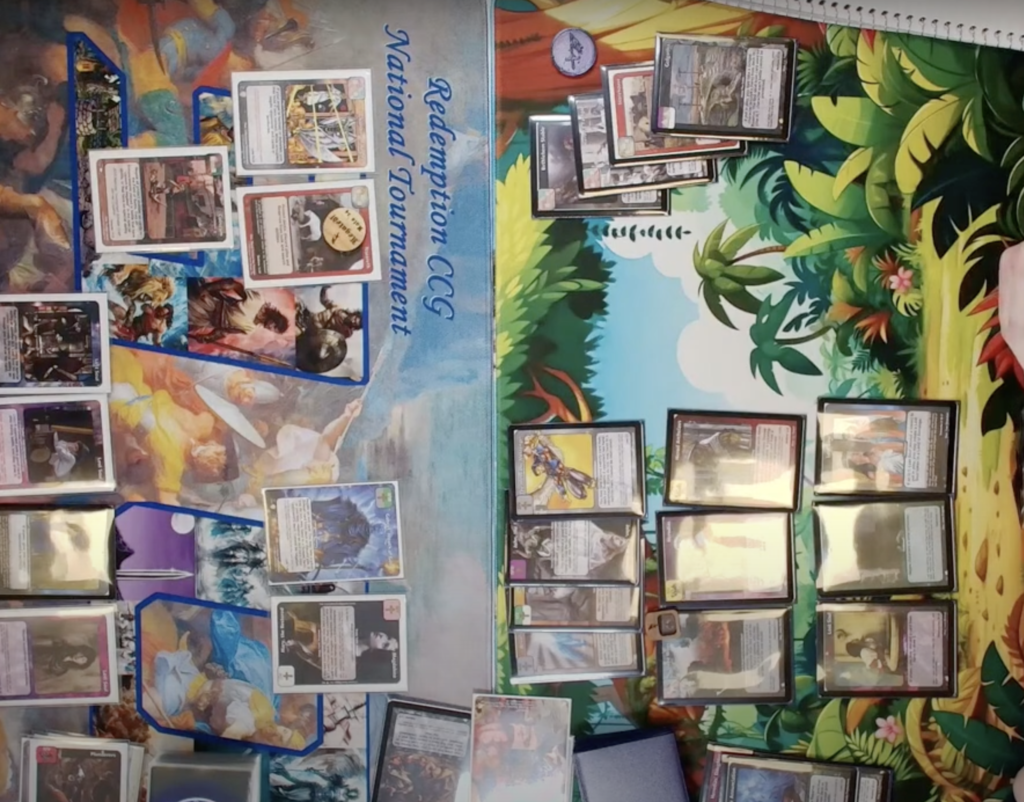
After this, I was able to enact a hand-control gameplay which stripped him of what little blocking power he had. Jayden never quite got enough cards to get back in the game, and my defense held strong. I believe the final score was 5-3 or 5-2.
Topcut: Finals
In the finals I was pleasantly surprised to see my fellow Nativity teammate and friend Jake! Since we had both worked together on the deck and decided to register nearly identical versions of the deck, we both knew exactly what the other person was playing. It promised to be an interesting match but we guessed whoever went first would probably have the advantage. You can watch the full match here.
He won the die roll and proceeded to have a nutty turn 1 attack which I could not contest. This was his board state at the end of his first turn: He had approximately 22 cards in play while I had a single lost soul out by the time I started my first turn.
Jake’s Turn 1 (left) vs the start of my Turn 1 (right)
Crucially, he decided to use a Star of Bethlehem to try and dig 6 cards into his deck for his copy of Wall of Protection. He knew that if he allowed me to start banding to some of his Heroes, I might be able to get my foot back in the door and catch up on cards.
This is exactly what happened. I was able to also have a great turn one and it helped that I could band to any of his heroes. While not as fantastic as his start, my Turn 1 allowed me to generate the resources I needed to block him and also put a Herodias into play that would limit access to his reserve. I also drew my copy of Wall of Protection which would prevent him from banding to my Mary.
During Jake’s second turn, a judge warned him that his 30 second window for putting a hero into battle was expiring. Jake pushed with a lone Joseph, forgetting he wasn’t able to band to Mary. I had a Christian Martyr which stopped Joseph dead in his tracks. This is where the momentum of the game started to shift.
I was able to negate his Herodias and get into my reserve. A big attack + drawing some more cards meant I was able to muscle past his block. Luckily he didn’t have a No Straw in his hand to punish a misplay I made where I thought I had access to Flight into Egypt. On his turn he activates Confusion of Mind and comes in with a big banding chain of heroes. In order to try and play around Glory of the Lord, I try to match how big he banded by going Herod Phillip into Herod Agrippa I. He negates my protection but gives me initiative to play a No Straw which topdecked all of his heroes and pushed him farther behind.
During this block however we both missed the fact that his Herodias was “online” again since he was negating my Elizabeth. I shouldn’t have been able to search my reserve that turn. I’m not sure if that would have affected the outcome of the game, but I still feel bad in retrospect about missing that. We caught it by the time my upkeep rolled around, but by that point it was too late to go back and replay anything. We both decided to move on and continue playing.
He knew I had enough tossing power to take down anything he tried to block and then start a tossing battle with, so he was forced to continue giving up souls because I didn’t let him play his No Straw on my heroes by giving them protection with Flight into Egypt + Star of Bethany.
I was able to close out the game by attacking with a lone Zechariah, the Silent because I knew he had a Glory of the Lord in his hand in all likelihood. However if he had Christian Martyr, Zechariah was a sitting duck. He didn’t have the Christian Martyr, and extended his hand in gracious defeat.
Parting Thoughts
It was surreal getting to be presented with the T1 2P award plaque + promo cards. It was certainly a dream come true! I’m still searching for words to describe what this event means to me and how I feel. In place of words, I’ll just show you some pictures:
(Jake: Far left 2nd place, Jayden: 2nd from left 3rd place, Me: 3rd from left 1st place, tournament host Ron far right)
1st, 2nd, and 3rd place promotional cards + Ultra Rares from Israels Inheritance
The trophy for winning the T1 2P event:
Thank You!
I would like to dedicate the end of this article to thanking those who have helped and supported me on my journey. I certainly could not have accomplished this without you.
My mentors of the game: Jake, Tyler, Chad, MrMiYoda, and Jay. Thank you for sharing your wisdom with me.
My Lackey playtest partners: Reth, BeardedGuy, Jay, Null, JoshP, Gilbaugh, Justin and all the other lackey players. Thank you for giving me a space to try out new ideas and bring polished ones to the tables. Thank you for being patient with me as I learned the game and thank you for being gracious in victory and gracious in defeat.
My brothers Andy and Joe: thank you for supporting my and cheering for me! Thank you Andy for helping me get back into the game and thanks Joe for getting me the bag I used to carry all my cards at Nationals. And thank you Marcus McDaniel for first teaching me how to play Redemption all those years ago.
Thank you content creators: Jayden, John Hendrix, Tyler (again) and Chad, thank you for putting resources out that that have helped players like me learn and master the game of Redemption. Thanks for inspiring me to start my journey as a content creator.
RedemptionAggie: Thank you for answering the countless ruling questions I’ve thrown at you. No other person has contributed in helping me understand the game like you have.
AirBnB house: thanks for inviting me to get to stay with you guys. I had a phenomenal time and it was an honor to stay with you during the tournament.
Jesus, thank you for giving me the ability to learn, the drive to compete, and the ability to share. I’m truly blessed.
Anyways, thanks for reading, and I’ll catch you all in another video!
To buy singles, sealed product, and other gaming supplies mentioned, please visit our sponsors!

